Burundi Travel Guide
This is a Burundi Travel Guide from taste2travel.com
Date Visited: May 2023
Introduction

Burundi is predominantly a mountainous country.
Burundi is a landlocked country which sits very much in the shadow of neighbouring Rwanda, which has itself undergone a remarkable renaissance in recent years.
While the Rwandan capital, Kigali, is modern and glitzy, the capital of Burundi, Bujumbura, is more gritty, dusty and chaotic. Most accommodation options in the Bujumbura are located along the breezy shores of the gigantic Lake Tanganyika, the longest freshwater lake on the world.
If your time in Burundi is limited to visiting just the capital, you will come away with a less than favourable impression of the country. The true gems of Burundi are to be found away from the capital, high up in the nearby mountains.

The hilly, mountainous terrain of Burundi is perfect for tea cultivation, seen here at the Taza Tea Plantation.
Burundi has a troubled history marked by ethnic tensions and conflicts. In 1962, it gained independence from Belgium and became a republic.

Watching a performance by the Gishora Royal Drummers is a highlight of Burundi.
The country has experienced periods of political instability, including a civil war between Hutu and Tutsi factions that lasted from 1993 to 2006 and resulted in widespread violence and loss of life.

Walking through the Taza Tea Plantation and meeting the tea pickers was a wonderful memory of Burundi.
Since the end of the civil war, Burundi has made progress in terms of political stability and socio-economic development. However, challenges such as poverty, corruption, and limited access to basic services persist.

The former Royal Palace and some of the many drums used by the Royal Drummers at Gishora.
Burundi is known for its rich cultural heritage, including traditional dances, music, and crafts. The drumming tradition holds significant cultural importance in the country.

The colours of Burundi, featured in souvenir trinkets.
In terms of governance, Burundi is a presidential republic. The president is both the head of state and the head of government. The country has faced criticism for its human rights record and restrictions on political freedoms.
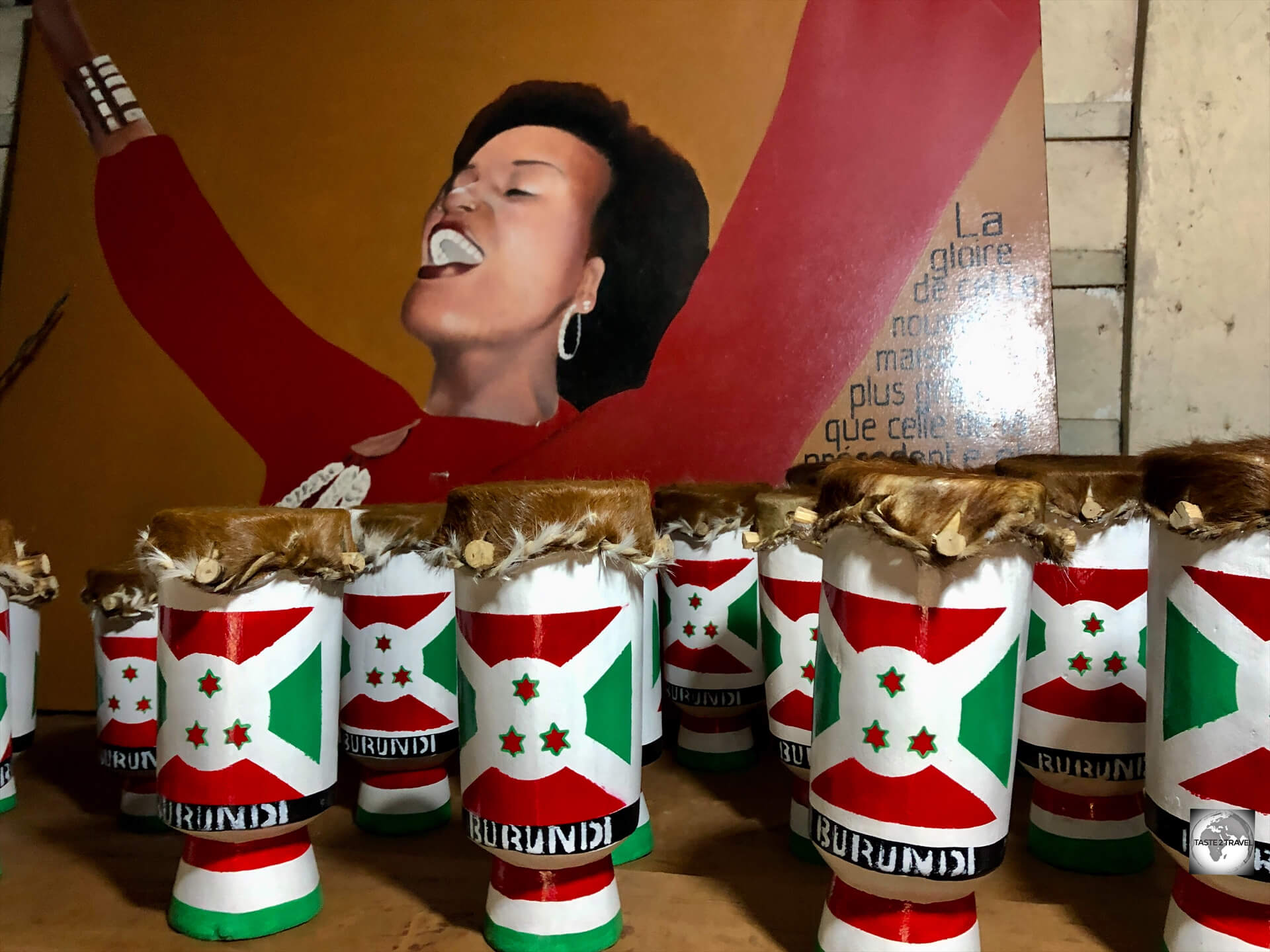
Drumming is an integral part of Burundian culture.
Overall, Burundi is a country with a complex history and ongoing challenges. While it has made progress in some areas, there is still a need for sustained efforts to address socio-economic issues and promote peace and stability.
I enjoyed my time in Burundi and was pleasantly surprised by what I saw and experienced. I look forward to returning again one day to explore the country further.
Location
Bujumbura, Burundi
Burundi is a land-locked, and mostly mountainous country, which is located in East Africa. Although it does not have access to any ocean, it is located on the massive Lake Tanganyika which is the world’s longest freshwater lake at 673 km (418 mi) in length.
The lake is shared among four countries – Tanzania, the Democratic Republic of the Congo (DRC), Zambia and Burundi.

A souvenir at the Bujumbura craft market, this wooden map of Burundi shows the different regions.
Burundi is bordered by Rwanda to the north, Tanzania to the east and southeast, and the Democratic Republic of the Congo (DRC) to the west.
It is a relatively small country, covering an area of approximately 27,834 square kilometres (10,747 square miles) – making it slightly smaller than Belgium and slightly larger than neighbouring Rwanda.

Lake Tanganyika is the world’s longest fresh water lake.
Burundi has a diverse topography, with varying elevations and landscapes.

Much of Burundi is hilly and mountainous.
The central and eastern parts of the country are dominated by high plateaus and hills, while the western border is formed by Lake Tanganyika, which is one of the deepest and longest lakes in the world.

A view from the mountains, towards Bujumbura, shows the large plain on which the capital is located.
The capital, Bujumbura, is located in a broad valley, on the shores of Lake Tanganyika. It is the only flat area of land in the entire country.
Burundi is part of the Great Rift Valley, a geological feature that stretches across East Africa. The western border of the country, formed by Lake Tanganyika, lies within the Rift Valley.
People

Burundians, such as these tea pickers at the Taza Tea Plantation, are generally friendly and welcoming.
The people of Burundi are diverse, with various ethnic groups contributing to the country’s rich cultural fabric. The two main ethnic groups in Burundi are the Hutu and Tutsi, with the Hutu comprising the majority of the population.
Other smaller ethnic groups include the Twa, who are traditionally hunter-gatherers, and the Ganwa, who are agriculturalists.
The well-known conflict between the Hutu and Tutsi is essentially a class war, with the Tutsis perceived to have greater wealth and social status (as well as favouring cattle ranching over what is seen as the lower-class farming of the Hutus).

Drumming, seen here at Gishora, is an important part of Burundian culture.
In Burundi, the Hutu people are the largest ethnic group, constituting the majority of the population. They primarily engage in agriculture and make up a significant portion of the rural communities.
Approximately 90% of the country’s population is dependent on agriculture, but in what is a very hilly and mountainous country, agricultural productivity, and access to farmable land are low.
The Hutu have their own language, Kirundi, which is widely spoken throughout the country. Kirundi speakers are also found in neighbouring countries such as Rwanda, Uganda, Tanzania and the Democratic Republic of Congo.
The Tutsi people, although a minority, have played a prominent role in Burundi’s history. Traditionally, they were cattle herders and were historically associated with political and social leadership roles.
However, it is important to note that ethnic distinctions in Burundi have been a source of conflict in the past, and today efforts are being made to promote national unity and reconciliation.
The government, and various organisations, are working to promote unity, social cohesion, and the recognition of shared citizenship among the people of Burundi.
The Hutu and Tutsi

Burundi is a largely agricultural country.
In Rwanda and Burundi, the Tutsi and the Hutu are, ethnically, the same people. The distinction is one purely of class, but this distinction has had a devastating impact on relations between all who call Rwanda, and Burundi, home.
During the Rwandan genocide of 1994, it is estimated that approximately 800,000 Tutsi were massacred by Hutu militia groups.
This class classification has existed for centuries. People were classed as either Tutsi or Hutu, depending on their proximity to the king. If you were close to the king, you owned wealth, you owned a lot of cattle, you were a Tutsi.
If you were more distant from the king, you were a cultivator, you didn’t own much cattle, you were a Hutu.
Colonial rule, which began in the late 19th Century, did little to bring the groups together. The Belgians, who ruled what would later become Rwanda and Burundi, forced Hutus and Tutsis to carry ethnic identity cards.
The colonial administrators further exacerbated divisions by only allowing Tutsis to attain higher education and hold positions of power.
It was a classic strategy of ‘divide and conquer’, but it laid for the roots for the devastating genocide of 1994.
Flag

A hand-painted flag of Burundi adorns a souvenir shield.
The flag of Burundi was adopted on June 28, 1967, when the country gained independence from Belgian colonial rule. It was designed by a local artist and has remained unchanged since its adoption.

The flag of Burundi.
The flag consists of a rectangular design divided into three equal horizontal bands of red, white, and green, from top to bottom.
At the centre of the white band, there is a large, circular representation of three red, six-pointed, stars outlined in green. The stars are arranged in a triangular shape, with two stars forming the base and one star at the apex.
The red band represents the struggle for independence and the sacrifices made by the Burundian people, while the white band symbolises peace. It also signifies the desire for peaceful coexistence and harmony among the country’s different ethnic groups.

The colours of the Burundi flag feature in many souvenirs.
The green band represents hope for a prosperous future and the country’s agricultural wealth. It symbolises the importance of agriculture in Burundi’s economy and the country’s commitment to environmental sustainability.
The three red six-pointed stars on the flag hold several meanings. They represent the three ethnic groups of Burundi – Hutu, Tutsi, and Twa – coming together in unity. The green outline of the stars represents the country’s lush vegetation and natural resources.
Currency

The official currency of Burundi is the Burundian franc (BIF).
The official currency of Burundi is the Burundian franc (BIF). The currency is abbreviated as “BIF” and is represented by the symbol “FBu” or “F”.
The franc is nominally subdivided into 100 centimes, although coins have never been issued in centimes since Burundi began issuing its own currency.

The 10,000 BIF bank note is the largest denomination note in Burundi.
The Burundian franc is issued by the Central Bank of Burundi, which is known as the Bank of the Republic of Burundi.
Bank notes are issued in denominations of 100, 500, 1000, 2000, 5000 and 10000 BIF.

Released during my visit, two new beige 5,000 BIF banknotes, with the older blue note in the centre.
On the last day of my visit, the government issued a new 5,000 BIF bank note which is the exact same design as the previ0us note, with the only difference being the colour – a change from light blue to beige.
Currency Black Market
A currency black market exists in Burundi with the rates changing constantly.
At the time of my visit, the following rates applied:
- Unofficially: US$1 = BIF 4,000
- Officially: US$1 = BIF 2,831
The option to use the black market exists in many safe places in Bujumbura – ask at any money changer!
No need to take risks by exchanging money on the street.
Credit Cards
Generally, credit cards are not accepted in Burundi.
Larger hotels (e.g. Hotel Safari Gate) will allow guests to settle their bill with a credit card, however, due to government restrictions, tour companies and every other company are unable to accept payments with credit card.
It’s best to bring enough USD cash to cover all expenses while in Burundi.
ATM’s
You should avoid using ATMs in Burundi, unless you wish to purchase BIF at the (unfavourable) official exchange rate!
Costs

Menu prices at a restaurant in Bujumbura.
Burundi is an affordable travel destination, especially if you are changing money on the black market.
Sample costs (using black market rate)
- Room at the Hotel Safari Gate in Bujumbura (including breakfast): US$65 per night.
- Meal (budget restaurant): US$5 – 10
- Meal (mid-range restaurant): US$15 – 20
- Primus Beer (0.5L): US$1
- Cappuccino: US$1.30
Sightseeing
Sightseeing in Burundi offers a unique blend of natural beauty, cultural heritage, and historical significance. Despite its small size, Burundi boasts a variety of attractions that can appeal to different interests.

Inexpensive, handmade cards make for ideal souvenirs of Burundi.
To appreciate the true beauty of Burundi, it’s essential to leave the hot and dusty capital of Bujumbura and venture into the interior, where you’ll find a much cooler climate and picturesque, green, hilly countryside dominated by tea plantations and farmlands.

A typical view of the hilly interior of Burundi.
Near the former capital of Gitega, the Gishora Royal Drummers are one of the main attractions of Burundi.
Tour Operators

The wonderful Uwimana Dative, the enthusiastic CEO of Ikaze Ventures, in her office in Bujumbura.
While in Burundi, I occasionally used the services of Ikaze Ventures, a tour company which is owned by the amazing Uwimana Dative (IG: dative_dalor_uwiman/), who is very enthusiastic about tourism in her beloved Burundi.
At the age of 25, Uwimana is a motivated entrepreneur, CEO and a former winner of “Miss Popularity” in Burundi. She is highly driven and this shows in the level of service she provides her clients.

I visited the Gishora Royal Drummers with Ikaze Ventures.
Through her leadership, Ikaze Ventures has trained, and utilises, a team of local female guides.
Public transport outside of Bujumbura isn’t readily available, and most of the main sights, e.g. Tea Plantations, the Gishora Royal Drummers, cannot be easily reached by public transport. It’s much more convenient to utilise a tour company such as Ikaze Ventures.

- Email: ikazeventures7@gmail.com
- Tel: +257 61 88 73 95
- Website: https://ikazeventures.com/
Bujumbura
The capital and largest city of Burundi, Bujumbura (Pop: 375,000) is a fairly unremarkable place. Hot, dusty and chaotic, the capital is located on a hot, lakeside plain, the only flat piece of land in Burundi.

A view of downtown Bujumbura, the capital of Burundi.
Bujumbura is located on the north-eastern shore of Lake Tanganyika, the second deepest lake in the world after Lake Baikal. Most worthwhile accommodation options, and restaurants, are located along the lakeshore.
Lake Tanganyika

The beaches of Lake Tanganyika are a highlight of Bujumbura.
The main attraction of Bujumbura is the immense Lake Tanganyika, the world’s longest freshwater lake. There are many sandy beaches (some man-made) along the lakeshore. Boats are available for lake cruises.
Bujumbura Craft Market
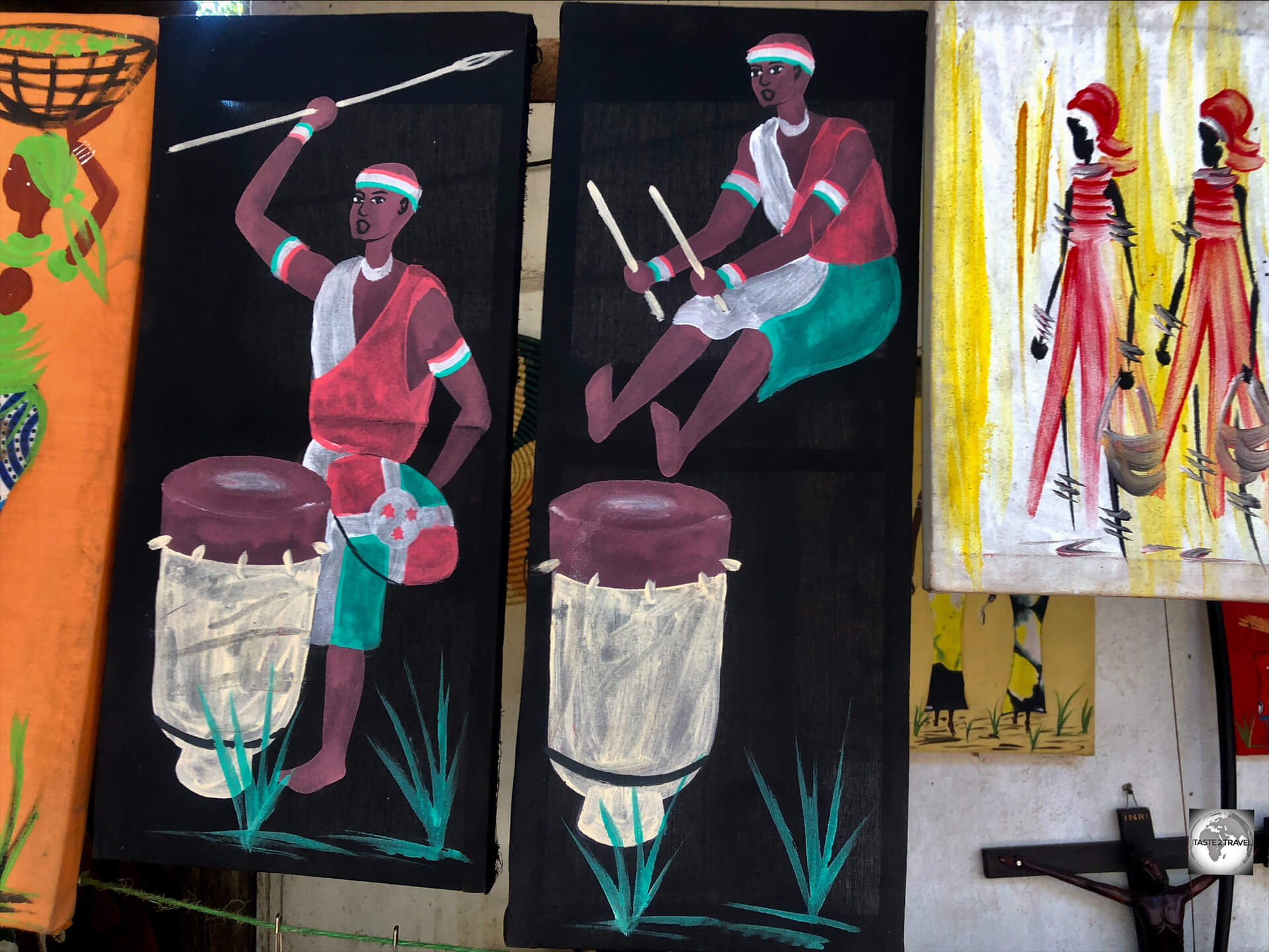
Paintings for sale at the Bujumbura craft market.
Located in downtown Bujumbura, the small Bujumbura craft market is a great place to pick up bargain souvenirs and gifts.

Masks for sale at the Bujumbura craft market.
Prices asked by the vendors at the craft market are very reasonable. It’s the best souvenir shopping in town.

The shops at the Bujumbura craft market are full of bargain souvenirs.
Gishora Royal Drummers

A must-see in Burundi – the Gishora Royal Drummers.
The #1 tourist attraction in Burundi, the Gishora Royal Drummers are a renowned cultural group known for their exceptional drumming performances and their role in preserving and promoting the country’s traditional music and heritage.

The Gishora Royal Drummers offer a powerful performance.
Drumming has deep cultural and historical significance in Burundi, often used to communicate messages, celebrate important events, and accompany various ceremonies.

A high energy performance by the Gishora Royal Drummers.
I visited the Gishora Royal Drummers with Ikaze Ventures as part of a day-trip which included a visit to the Taza Tea Plantation.

Watching the electrifying performance by the Gishora Royal Drummers is a memorable experience.
The drummers are named after the village of Gishora, located near the former capital of Gitega, which is considered the cultural heart of Burundi.

No shortage of energy from the Gishora Royal Drummers.
Video: Gishora Royal Drummers
Gitega is located 100 km due east of Bujumbura, a drive of 2 hours along a windy, mountainous highway.

The Gishora Royal Drummers.
Video: Gishora Royal Drummers
Performances are staged on demand, whenever tourists arrive at the performance compound, and run for one hour.

Lots of high jumps by the athletic Gishora Royal Drummers.
The performance involves a great amount of energy and is truly electrifying to watch. While it is a show for tourists, it is thrilling and exciting to watch.

The Gishora Royal Drummers provide a display of athleticism during their performance.
Gishora Royal Palace

A view of the Royal Palace at Gishora.
The Gishora Royal Drummers perform at the former Royal Palace compound which is located a short drive from the former capital of Gitega.

A view of the interior of the former Royal Palace at Gishora.
A visit to the drummers will include a visit to the palace which remains largely unchanged.
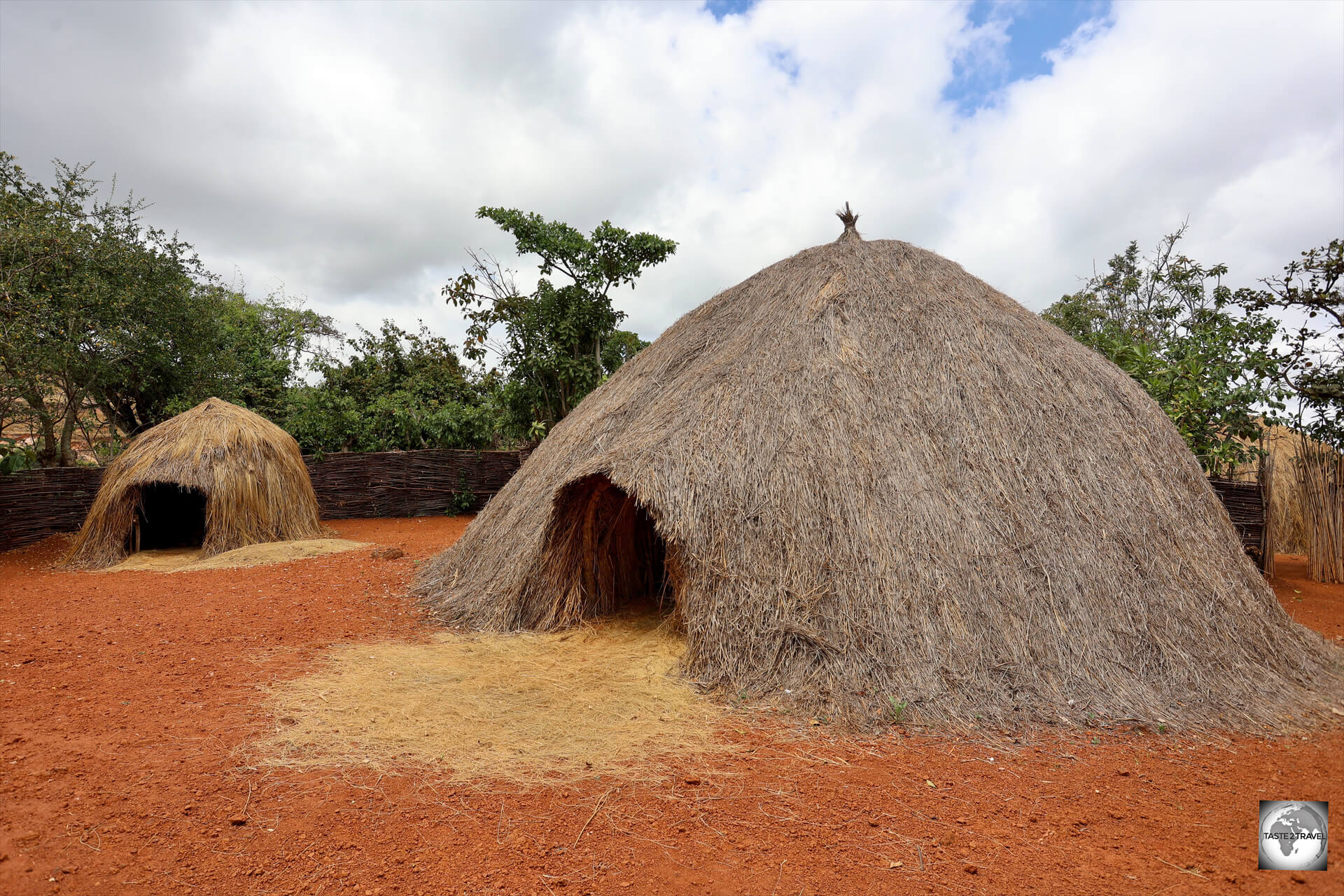
The royal compound at Gishora.
The royal estate of Gishora dates from the early 19th century, when the Burundi kingdom had a series of regional palaces.

A view of the Royal Drum Shrine at the Gishora Royal Palace.
The Gishora estate consisted of the royal residence, the sacred drums shrine and the house of the servants.
The drum shrine houses two ritual drums that are never beaten: Ruciteme (the one for whom we clear the forest) and Murimirwa (the one for whom we cultivate). Both drums rest on a table inside a dedicated hut.

An interior view of the Royal Palace at Gishora.
The royal residence was a courtyard exclusively accessible to the royal family.

A Gishora Royal Drummer, and a selection of drums, alongside the Royal Palace.
In 1966 King Mwambutsa IV was deposed by Prince Ntare V. Ntare V’s rule was however short lived as he was in turn deposed in a coup led by prime minister Captain Michel Micombero.

A view of the interior roof of the Royal Palace at Gishora.
The military coup meant the end of Burundi as a kingdom, this ended a royal tradition going back to the later 1600s.
Taza Tea Plantation

A view of the Taza Tea Plantation.
Burundi is known for its tea production, which is an important sector of the country’s economy.

With my guide, Uwimana Dative, and a representative from Taza Tea, prior to our walk through the plantation.
Tea cultivation and processing have been significant contributors to employment and export revenue.

Exploring the Taza Tea Plantation.
In 2021, Burundi exported $28.6M in tea, making it the 27th largest exporter of tea in the world. At the same year, tea was the 3rd most exported product in Burundi.

Tea pickers at the Taza Tea Plantation.
The main destinations of tea exports from Burundi are: Pakistan, Oman, Egypt, China, and United Kingdom.

Freshly picked tea leaves at the Taza Tea Plantation.
The country’s favorable climate and altitude make it suitable for growing high-quality tea.

A tea picker at the Taza Tea Plantation.
As part of a day-trip with Ikaze Ventures, I had the privilege of spending time with the tea pickers at the Taza Tea Plantation.

Very fresh souvenir tea leaves at the Taza Tea Plantation.
For about one hour, I walked with my guide, Uwimana Dative, and a representative from Taza Tea, through the extensive tea plantation.
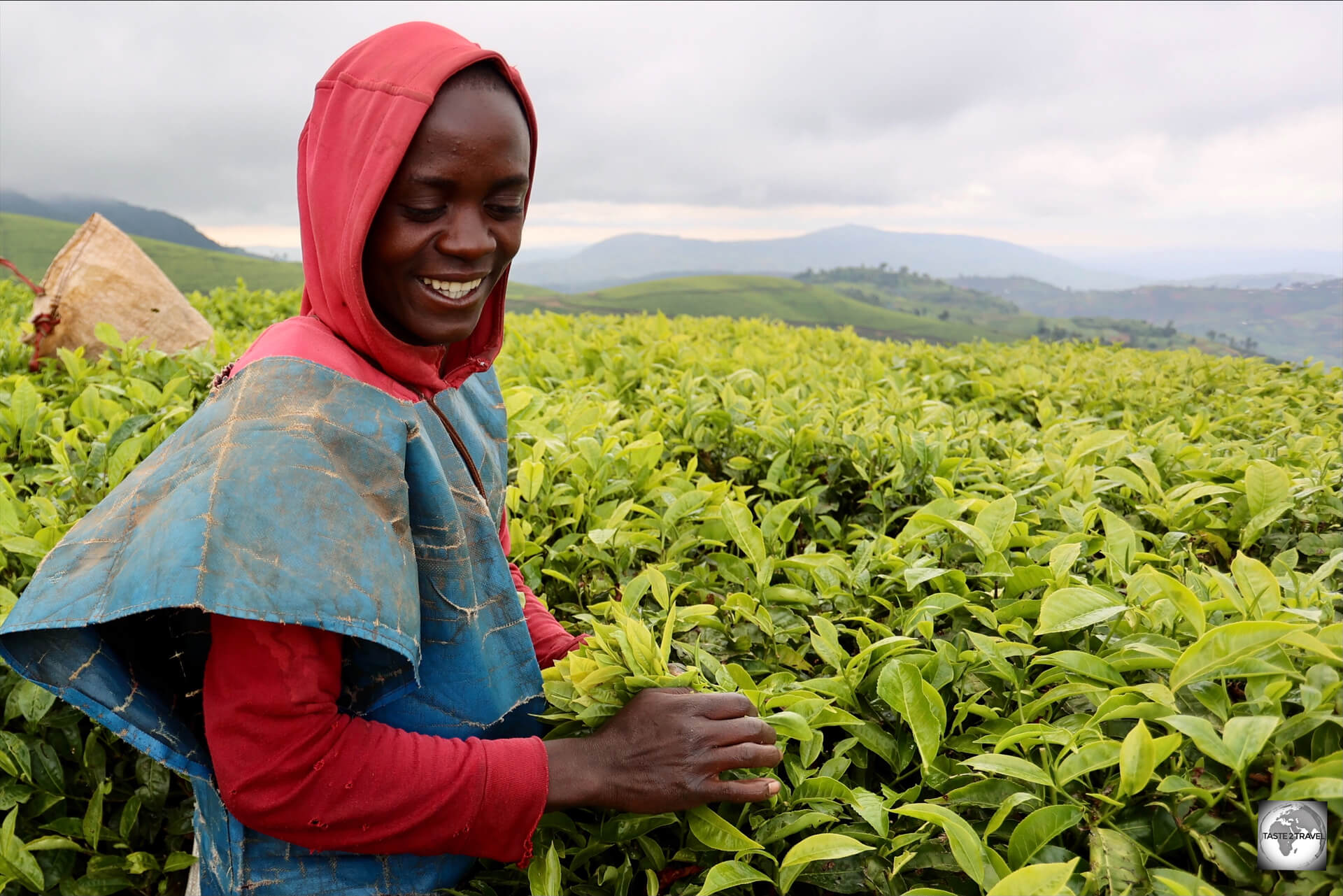
Picking tea leaves at the Taza Tea Plantation.
I was able to witness the tea picking process up close and was able to pick some leaves to chew on – something the pickers like to do!

Walking through the Taza Tea Plantation.
Dramatic, cloudy skies made for moody photography and the pickers were great fun to be around. They enjoyed being photographed.
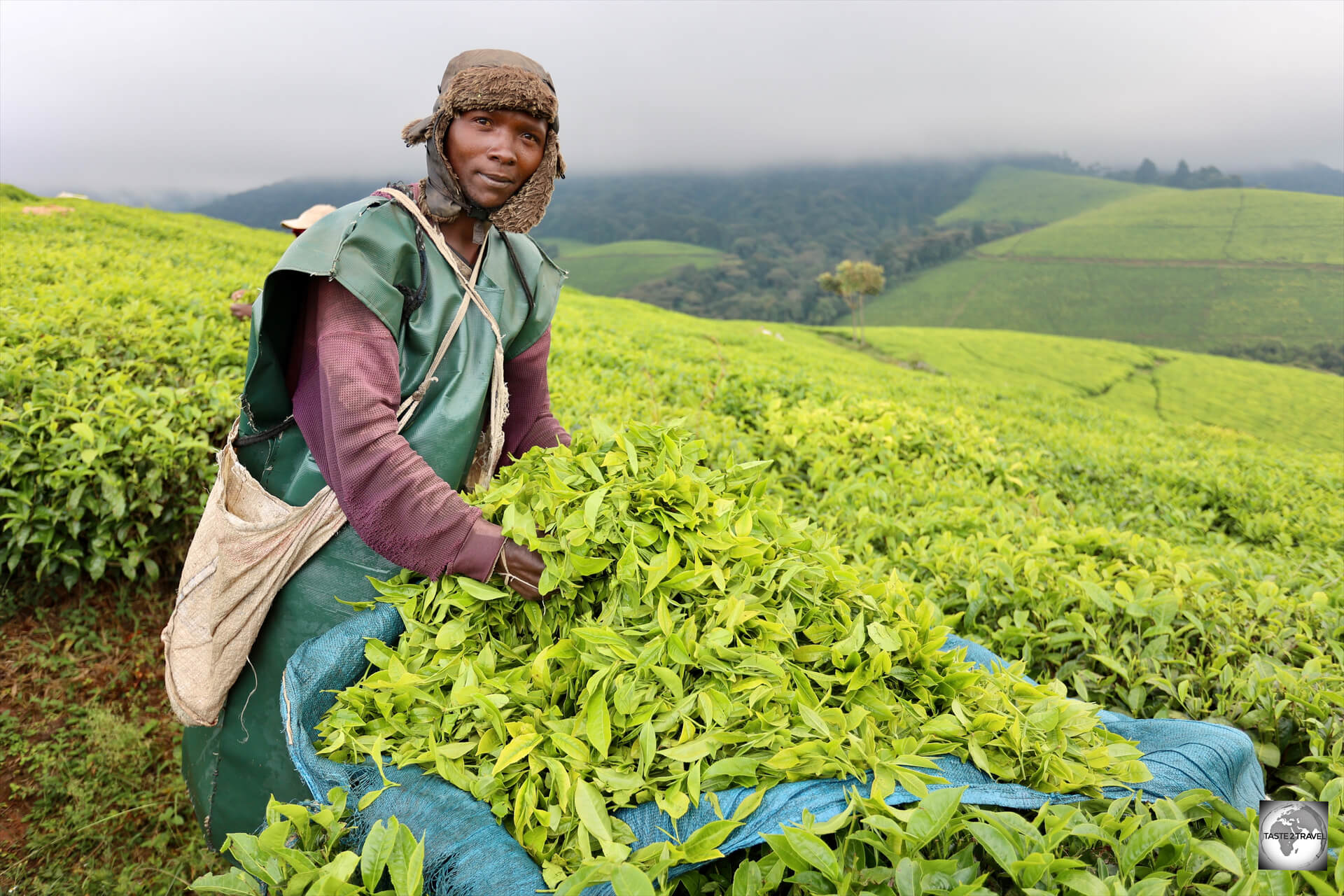
A tea picker at the Taza Tea Plantation.
Accommodation

The Hotel Safari Gate is a popular accommodation choice in Bujumbura.
While in Burundi, I stayed at the comfortable, but tired and dated, Hotel Safari Gate which lies on the shores of Lake Tanganyika.

My comfortable room at the Hotel Safari Gate.
A standard room on booking.com costs around US$65 per night.

The swimming pool at the Hotel Safari Gate.
The hotel offers a swimming pool, gym and a lake-front restaurant where breakfast is served each morning.

At the time of my visit, the lakeside restaurant at Hotel Safari Gate was slightly inundated by high water.
There are newer, more contemporary, hotel options further along the lakeshore.

The view from my balcony at the hotel Safari Gate in Bujumbura, which overlooked the extensive garden.
Eating Out
Burundian cuisine is influenced by a combination of local ingredients, traditional cooking methods, and cultural practices. The country’s cuisine reflects its agricultural heritage, with an emphasis on locally grown produce, grains, and legumes.
One of the most popular staples is Ugali (Sima), a thick porridge made from maize (corn) flour, similar to other East African countries. It is a common accompaniment to many meals such as stewed meat.
Restaurants / Cafés
Most restaurants in Bujumbura can be found in the various hotels which line the shore of Lake Tanganyika.

Le Café Gourmand, one of the best cafes in Bujumbura
In downtown Bujumbura, both the Bujacafe and Le Café Gourmand serve very good café style food.

Always an impressive selection of pastries at Le Café Gourmand in Bujumbura.
Located on Avenue de France, Le Café Gourmand is one of the most popular cafes in Bujumbura, serving freshly baked breads and pastries, and offering a menu of delicious sandwiches and tasty coffee.

The rooftop terrace at Le Café Gourmand.
The best place to sit at Le Café Gourmand is the rooftop terrace, which affords panoramic views of downtown Bujumbura.

A view of downtown Bujumbura from the terrace of Le Café Gourmand.
The coffee, pastries and food at Le Café Gourmand are always excellent.

A delicious chicken sandwich and coffee, at Le Café Gourmand in Bujumbura.
Not to be outdone, the popular Bujacafe also offers very good coffee and food in a leafy garden space in downtown Bujumbura.

A fine café latte, served at Bujacafe.
Bars

‘Primus’ is the local beer of choice in Burundi.
Alcohol is served at many restaurants in Bujumbura, with South African wines and local beers such as Primus standard favourites.

Primus beer is served at most restaurants in Bujumbura.
Visa Requirements

My Burundian Visa-on-Arrival (VOA) which was issued at Bujumbura International Airport.
The Visa Policy of Burundi is wonderfully simple.
Nationals of a few neighbouring countries, the East African Community (EAC), enjoy visa-free travel to Burundi, while all other nationalities can apply for a Visa-on-Arrival (VOA) at both Bujumbura International Airport and at all land borders.

Visa requirement map for Burundi: countries in gold can apply for a VOA, while countries in green enjoy visa-free entry.
Source: Wikipedia
It’s important to note that while a VOA is available at all border entry points – both at land borders and at Bujumbura International Airport, you can only apply for a full VOA (i.e. valid for a stay of one month) at Bujumbura airport.

The entry/ exit form at Bujumbura International Airport.
If you enter via a land border, you’ll be issued with a ‘transit’ VOA which is valid for 3 days! If you wish to stay longer in the country, you’ll need to get your transit visa extended in Bujumbura, which is a process that can take the best part of a day.

My Burundi entry stamp.
You can save yourself considerable time and hassle by using a local tour operator, such as Dative to take care of the extension for you. Her company can secure extensions in a matter of hours while you are busy sightseeing.
Summary of visa costs (@ June 2023):
- One month entry visa (Bujumbura airport only) = US$90
- 3-day transit visa (Bujumbura airport and all land borders) = US$40
- Visa extension in Bujumbura (to convert transit visa into one month visa) = US$10
As can be noted from the above fees, if you are a penny-pinching traveller, you could secure a one-month visa for US$50 instead of the usual US$90 by first purchasing a transit visa for US$40 then extending it for an additional US$10.
The only negative is that you’ll spend most of one day in Bujumbura tied up in the extension process.
Getting There

Ethiopian Airlines is one of a few airlines which provide services to Bujumbura International Airport.
Air

Melchior Ndadaye International Airport – aka Bujumbura International Airport.
The only international airport in Burundi is Melchior Ndadaye International Airport – aka Bujumbura International Airport (IATA: BJM), which is located 8 km from downtown Bujumbura.

Boarding my RwandAir flight at Bujumbura International Airport, for my return flight to Kigali.
Built by the Belgium colonial authorities, the airport was opened in 1952 and remains mostly unchanged and unrenovated. The small terminal, which is open to the elements, lacks air-conditioning and is in a state of disrepair.
There is one café on the airside of the terminal which is operated by

The very old and dated departure hall at Bujumbura International Airport.
On 1 July 2019, the airport was renamed Melchior Ndadaye International Airport after the first democratically elected president of Burundi who was murdered in a coup d’état in October 1993, three months after being elected.

My RwandAir boarding pass, for my flight from Kigali to Bujumbura.
The following airlines operate scheduled services to/from
- Air Tanzania – flies to/ from Dar es Salaam, Kigoma
- Brussels Airlines – flies to/ from Brussels
- Ethiopian Airlines – flies to/ from Addis Ababa
- Kenya Airways – flies to/ from Nairobi–Jomo Kenyatta
- RwandAir – flies to/ from Kigali
- Uganda Airlines – flies to/ from Entebbe
Airport Transport

Leaving Bujumbura International Airport by taxi.
Taxis and hotel shuttle services typically charge US$20 for the 8 km trip between the airport and downtown Bujumbura.
Land
Entry into Burundi can be made overland from Rwanda, Tanzania and DRC.
As mentioned in the Visa section, 3-day transit visas can be purchased at all land borders for US$40. These can be extended in Bujumbura for an additional US$10.
Getting Around
The quality of roads and transportation infrastructure in mountainous Burundi can vary, especially in rural and remote areas. Some roads might be unpaved or in poor condition, making travel challenging.
Unlike neighbouring Rwanda, there are no speed cameras in Burundi which means the driving style is faster and more reckless!
The best option for exploring outside of Bujumbura is to utilise a tour company such as Ikaze Ventures, who will include a vehicle and driver.
Public Transport
Minibuses (Matatus) are a common mode of public transport in Burundi, especially in urban areas like the capital city, Bujumbura.
Matatus are privately operated and serve as a primary means of transportation for many residents. Often crowded, they follow set routes and pick up passengers along the way.
Motorbikes
Motorcycle taxis, known as boda-bodas, are a popular and often more convenient option for short-distance travel within cities and towns. They are commonly used for quick point-to-point trips and are readily available for hire.
Taxi
Taxis are available in urban areas and provide a relatively more comfortable and private mode of transportation compared to minibuses and boda-bodas. They can be hired for both short distances within a city and longer journeys.
Rental Car

A Burundi car license plate.
There are a few car rental companies in Bujumbura such as 4X4 Burundi, who offer cars starting at US$60 per day.
That’s the end of my travel guide for Burundi.
If you wish to leave a comment or feedback, please do so using the form below.
Safe Travels!
Darren
Author: Darren McLean
Darren McLean is an Australian, full-time, digital nomad who has spent 37 years on a slow meander around the globe, visiting all seven continents, 192/ 193 UN countries and 245/ 251 UN+ countries and territories.
He founded taste2travel to pique one’s curiosity and inspire wanderlust.







